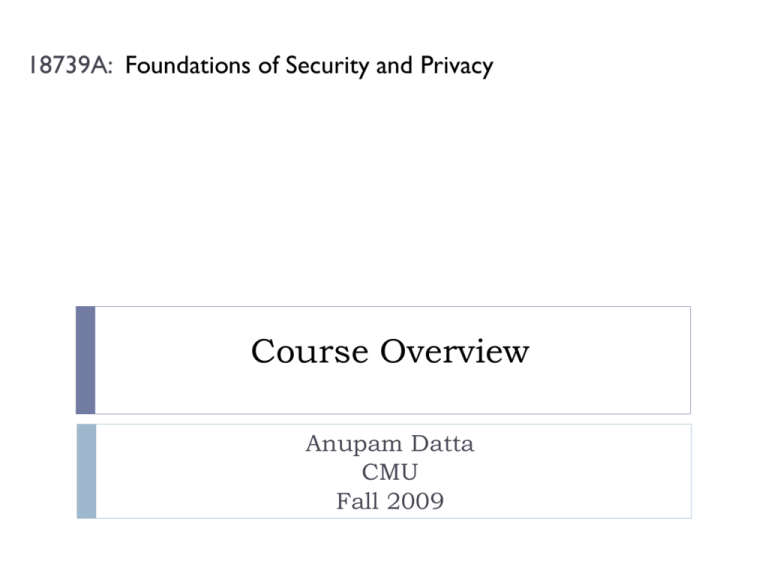18739A-CourseOverview - Electrical and Computer Engineering
advertisement

18739A: Foundations of Security and Privacy Course Overview Anupam Datta CMU Fall 2009 Course Staff Instructor: Anupam Datta Office: CIC 2118 Email: danupam@cmu.edu Office hours: Tue 4-5PM, Thur 5-6PM TA: Arunesh Sinha Office: CIC 2127C Email: aruneshs@cmu.edu Office hours: MF 1-2PM A Real-World Interaction (Protocol) Depositing a check at a bank 1. 2. 3. 4. 5. 3 Alice receives check from Bob Alice hands over check to teller Tyra Tyra sends check to Bob’s bank Bob’s bank verifies Bob’s signature Money transferred from Bob’s account to Alice’s account Questions for the class What are the desired security properties? Authentication : Bob must have written out the check for Alice Integrity: The check has not been modified by anyone other than Bob Non-repudiation: Bob cannot deny that he wrote a check if in fact he did Authorization: Is Bob authorized to withdraw $X in funds? Privacy: Bob’s bank should not share Bob’s financial information with other companies What can an adversary do to try to break the protocol? Forge check, steal an empty check, forge signature, edit check What mechanisms are used to achieve these properties? 4 Unforgeable signatures, uniqueness of handwriting, indelible ink, tamper evident paper (unauthenticated modification in body of check is detectable) Now throw the internet and software systems into the mix! Functional Correctness vs. Security Program or System Functional Correctness Program satisfies specification Program or System Security Program properties preserved in face of attack For reasonable input, get reasonable output For unreasonable input, output is not completely disastrous Main difference Active interference from adversary Plan for Today Course logistics Overview of topics and learning outcomes A quick tour of cryptographic primitives Logistics (1) Lectures: Tuesday & Thursday, 10:30-11:50AM, in SH 208 Recitation: Friday, 4-4:50PM, in SH 208 Web page: http://www.ece.cmu.edu/~ece739/ Course blackboard (linked from web page) Course work and grading: Homework (40%) – 4 x 10% Midterm exam(10%) – take home End term exam (10%) – take home Course project (30%) Class participation (10%) Logistics (2) Recitation: Friday, 4-4:50PM, in SH 208 Supplements topics discussed in class TA will discuss and demo various security analysis tools TA will also elaborate on examples and proof techniques discussed in class Should be useful for projects and homeworks First recitation this Friday Logistics (3) Course Project: Teams of 2 (form team by end of week) Project proposal: 1-2 pages (Due: Oct 8) Models/code (Due: Dec 1) Written report: 5-10 pages (Due: Dec 1) Final presentation in class (Dec 1,3) Project suggestions later in the lecture or pick your own Logistics (4) Collaboration policy on homeworks and exams: You are allowed to discuss solutions to written homework problems with other students in the class, but are required to write out solutions independently and to acknowledge any collaboration or other source. For programming/tools homeworks, you can work in groups of 2. You are required to work on the take home exams on your own. No collaboration is allowed. CMU Computing Policy CMU Policy on Cheating Prerequisites An introductory course in computer security such as 18-487, 18-630, or18-730 is recommended, but not required. If in doubt, please talk to me after class Quick class poll 10,000-foot View Four Broad Topics Security Protocols Access Control Privacy Software Security 13 Motivation: Web Purchase Secure communication using SSL/TLS SSL uses cryptography to protect data confidentiality and integrity, and guarantee entity authentication Many Protocols Authentication Key Exchange Huge practical impact, welldeveloped theory! Mobile IP, WEP, 802.11i Electronic commerce SSL/TLS handshake, IKE, JFK, IKEv2, Wireless and mobile computing Kerberos Contract signing, SET, electronic cash Anonymous communication Dining cryptographers, mixnets, crowds, onion routing Protocol Repositories: http://www.lsv.ens-cachan.fr/spore/, http://www.avispa-project.org/library Learning Outcomes (1) Security properties What does confidentiality, integrity, authentication, denial of service, fairness, anonymity mean? Adversary model What are the adversary’s capabilities – snoop on the network, inject traffic, do complicated math, jam network, observe timing effects,…? Protocol design How can cryptographic primitives be combined to achieve security in the presence of such adversaries? What kind of mistakes do protocol designers make? Protocol analysis How can we automatically find attacks on protocols? How can we prove security properties of protocols? Possible Project Topics (1) Analysis of protocols using existing methods/tools 1. Electronic voting protocols Anonymous communication protocols Protocols for the emerging smart electric grid Mobility protocols, e.g. Mobile IPv6 “Next generation” internet protocols (accountability) Develop/extend a protocol analysis method/tool 2. Automated prover for PCL (discussed later in class) Extended the ASPIER tool for protocol implementation verification Sample projects from protocols course at Stanford http://www.stanford.edu/class/cs259/projects.htm 18 Before we look at other topics A quick (de)tour of cryptography 19 Topic 2: Access Control Access Control Goal: Control which principals have access to which objects using a reference monitor that mediates access Examples: File systems, memory protection in OS, virtual machines, access to physical spaces, digital libraries, web browsers 21 CMU Distributed Access Control Goal: Flexible and scalable access control in large-scale, open, distributed systems Challenges: No central administration, each service makes its own access control decision Access control policy is distributed Distributed Access Control Example EPub Alice Grants access to university students Trusts universities to certify students Trusts ABU to certify universities Alice is a student StateU is a university ABU StateU Learning Outcomes (2) Access control concepts and foundations Principals, resources, reference monitor Policy expressed using access control matrix or logic Centralized and distributed policies Access control in practice Mechanisms in current OS, hypervisors Mechanisms based on checking proofs in an authorization logic (centralized and distributed) Case studies of the Grey system (used in CIC for access to physical spaces) and the Taos OS (original application for the seminal work on the Lampson et al authorization logic) Possible Project Topics (2) Access control in web browsers 1. Formal study of access control policies and mechanisms in modern web browsers Access control in hypervisors 2. 3. 25 Formal analysis of the TrustVisor system being developed at CMU, or of Xen’s protection mechanisms Adding flexible access control to svn Topic 3: Privacy 26 Data Privacy Huge amount of personal information available to various organizations Hospitals, financial institutions, websites, universities, census bureau, social networks Information shared within and across organizational boundaries to enable useful tasks to be completed 27 Personal health information has to be shared to enable diagnosis, treatment, billing Census bureau releases aggregate statistics Learning Outcomes (3) What is privacy? How is privacy compromised? Philosophical studies (Gavison, Contextual Integrity) Database privacy definitions (differential privacy) Policy expression in languages (P3P, Logic of Privacy) Privacy regulations in the US, e.g., HIPAA, GLBA Attacks on AOL & Netflix data sets, cases of HIPAA violation, end-user understanding of privacy promises How can we enforce privacy? 28 Achieving differential privacy Enforcing policies in the logic of privacy (the need for auditing) Possible Project Topics (3) Formalize a privacy regulation in a policy language Example: GLBA in the logic of privacy Develop a system for enforcing privacy policies 29 Example: For the logic of privacy Topic 4: Software Security Software Insecurity Root causes of security vulnerabilities in software Language does not protect the abstractions it provides Example: buffer overflow attacks are possible because C does not protect the array abstraction; not possible in Java Language does not provide high-level abstractions for developing security applications Example: Java does not provide abstractions for writing applications that enforce access or information flow control; similar issue for Javascript and web applications insecurity Learning outcomes (4) Understanding of how type systems can be used to improve software security Protecting language abstractions Cyclone: Memory safe dialect of C, i.e. no buffer overflow attacks Providing language abstractions Information flow control and the Volpano-Smith-Irvine type system Possible Project Topic (4) Develop a language for secure web programming 33 Not recommended unless you have significant experience with typed programming languages From “what” to “why”? Why study Foundations of Security? Our discipline of computer science seems to be one in which theory and practice are more intimately related than in any other field.....you can’t get very far in practical work without abstract theories that permit you to think at a higher level, and at the same time theoretical work becomes dead if it doesn’t receive fresh inspiration from practical problems in the “real world”. Don Knuth, Professor Emeritus of The Art of Computer Programming at Stanford University 5 Turing Award winning ideas! Rivest-Shamir-Adleman: RSA public key cryptosystem Lampson: Foundations of access control Clarke-Emerson-Sistla: Model-checking systems Hoare: Axiomatic reasoning about programs Milner: Theory of concurrency





